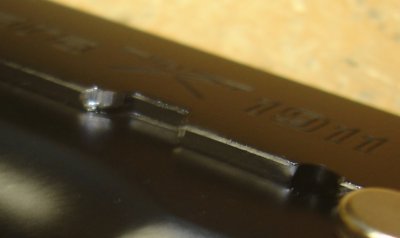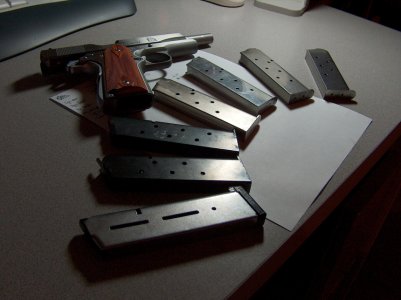Gross Anatomy
Feeding Time
Following Up
Conclusion
Frequently Asked Questions
Errata and Clarifications
Appendix: More Magazines
More articles
Discuss this article at

Note: I've added a second writeup on 1911 magazines. It can be reached via this direct link or by visiting the articles index. We now return you to your regularly scheduled website viewing.
Introduction
I recently got the opportunity to look at a selection of 1911 magazines. Alas, my good fortune came at another's expense: A friend of mine noticed a burr developing in the slidelock notch of his Para-Ordnance SSP along with some wear along the front side of the slide's slidestop cutaway after less than a thousand rounds. My friend returned the gun to Para-Ordnance for service, only to have it sent back with the burrs lightly dressed and a note saying that his warranty did not cover "normal wear," but they would not charge return shipping "in the interests of customer service." This is definitely not the behavior of a correctly-functioning 1911, but since help was clearly not going to come from Para-Ordnance, my opinion was requested. (Clearly an act of desparation.)

Houston, we have a problem.
After seeing the above photos, I opined that either his slide stop had a really sharp front edge to it and/or one of his magazines' followers was getting far too frisky with the slidelock's inner lug, forcing it up hard while the slide was still on its way back. Logic dictates that if all it takes to mangle is an overzealous follower, we'd see a lot more of these kinds of problems; maybe the heat-treating in this partcular slide is sub-par. Once you open the door to soft metal, though, it raises the possibility that any or all of the followers could play a part in the mangling process. There's also the chance that the slidelock could be getting bumped by a bullet on its way up enough to raise a ding, but not enough to induce premature slidelock; alternately, a thumbs-high hold hitting the slidelock could provide a similar bump from the outside. The only problems with these scenarios is that the burr's location looks pretty consistent and random bumps would have to happen with fairly high frequency to account for a ding like that. Of course, the follower theory would have less than 140 occurrences of aggressive follower rise resulting in a chewed up slide.
After hemming and hawing in this fashion for several minutes, I concluded that I couldn't say for sure without seeing the magazines. What was supposed to be a hypothetical became all too real: I got sent the mags, despite my protests that I couldn't guarantee a conclusive answer, a coherent analysis, or even the minimal level of competence required to avoid drooling on his magazines.
Truth be told, I was happy to be able to play with this wide a variety of mags. I've always been a staunch 1911 magazine traditionalist, which has limited my experience with the more varied examples of 1911 mags. My reasons for sticking with what many consider old-fashioned designs are good ones and I'll enumerate them later, but it would be worth the time to become familiar with other makes; maybe I'd even get lucky and have my assumptions proven wrong.

I love science.
So it was with great excitement and a dramatic photograph that I assembled the loaner magazines, a selection of mags from my own collection, and my trusty Mil-Spec to answer the following question: Is it possible that a magazine's follower is contributing to the slide peening, and what difference do all these different magazine designs make?
email: hidi.projects at gmail.com